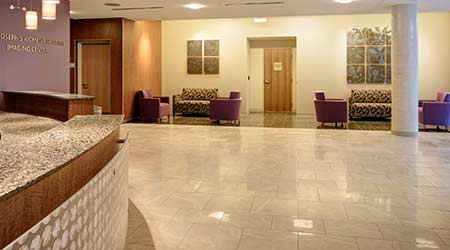« Back to Facilities Management Flooring Category Home
Seven Top-of-mind Hospital Flooring Considerations
December 20, 2016
- Flooring
By Aaron Hartung
From cleanliness and accessibility to heavy wear, wayfinding, and promoting a healing environment, hospitals face a unique, stringent set of challenges. The flooring is no exception. It’s a crucial part of creating a quality care setting. Below, we discuss various factors to consider when choosing flooring for your healthcare facility and how to incorporate evidence-based design into a hospital flooring plan.
When discussing evidence-based design (EBD) in hospital flooring, it’s a smart bet to lean heavily on the guidelines provided by The Center for Health Design (CHD), which in 2012 published a peer-reviewed guide to implementing EBD in the selection of healthcare flooring. The guide draws on EBD and original research, detailing industry best practices for flooring. This approach sees real results that help promote the wellbeing of those who walk through a healthcare facility’s doors. Here are some key considerations for weighing your healthcare flooring options.
1. Where the flooring is to be used. The entrance of a hospital and its corridors and clinical areas serve different purposes and will face different pressures. Entrances, for instance, are the first area patients, families, and visitors see in your hospital. They also experience some of the heaviest foot traffic. You’ll want a durable, welcoming floor that promotes your design vision and makes a strong first impression for your patrons. Corridors also see heavy use, including foot traffic and heavy rolling loads, such as equipment carts, stretchers, med carts, and wheelchairs. Clinical areas are at the highest risk of accumulating pathogens and other potentially harmful germs. Accordingly, no one flooring type will serve as a catch-all for your entire hospital. The decision about whether to use sheet vinyl, LVT, tile, or rubber flooring depends on many factors specific to the location within the facility in which it will be used.
2. Minimizing fall risk. Choosing the right flooring can minimize the risk of patients sustaining falls, so hospital flooring should be slip-resistant, impermeable, and easily cleaned. That’s all easy enough. But other EBD standards are not as obvious, such as recommendations for finishes. The finishing on hospital flooring should have a low reflectance value as to prevent glare, and joints and seams should be few and far between to prevent tripping.
3. Texture and noise absorption. Texture affects many aspects of a flooring’s performance, ranging from noise absorbance to reducing injuries relating to falling. Preventing falls is important, but they will inevitably happen, and floors that have energy-absorbent properties will minimize injuries of staff or patients who fall. This can also be achieved through underlays that will increase cushioning. Underlays and finishes can also be used for noise absorbance, reducing noise from rolling carts or heavy foot traffic.
4. Reducing staff fatigue. Nurses, doctors, and other healthcare facility personnel work long shifts. And, for much of those shifts, they’re on their feet. Cushioned flooring or mats can reduce staff fatigue, saving their feet and their sanity. However, the CHD recommends that cushioning be combined with roller mobility, so that equipment can still be transferred easily.
5. Minimizing risk of healthcare-associated infections (HAI). HAI is a healthcare facility’s nightmare. EBD can guide hospitals in choosing flooring that best mitigates the risk of HAI, while improving the overall patient experience. The CHD has a host of recommendations to this end. They recommend against using carpet, especially in burn units and operating rooms, where the risk for airborne pathogens is high. Rather, they suggest using impermeable materials that can easily be cleaned.
6. Color and design. Color is crucial to simplifying wayfinding within the many corridors and wings in many hospitals. Colors and patterns can aid in promoting a “non-institutional” atmosphere, while aiding in wayfinding. Of course, because some patrons of healthcare facilities have sensitive eyes, the CHD recommends using non-glare finishes.
7. Going green. LEED guidelines shouldn’t be ignored when choosing a flooring solution that works for you. In addition to allowing your facility to be in accordance with the U.S. Green Building Council’s standards, choosing the right floor coverings will also improve the indoor air quality of your facility. The LEED for Healthcare guide offers guidance on how to best accomplish this.
Additional resources to consult:
• LEED for Healthcare — A flooring rating system developed by the U.S. Green Building Council (USGBC) that takes evidence-based design and indoor air quality into account.
• Green Guide for Healthcare — a best-practices guide for healthy and sustainable design, construction, and operations for healthcare facilities.
• FloorScore — a rating system developed by the Resilient Floor Covering Institute (RFCI) in conjunction with Scientific Certification Systems (SCS) that evaluates flooring for VOC emission levels and compliance with other rating systems.
• ecoScorecard — a composite tool showing flooring products that comply with the most popular rating systems.
• Spectra Trends in Commercial Flooring Guide — the latest in flooring materials, design and decision-making frameworks so you can select the best floor for your facility.
Using EBD to make your hospital flooring decisions boosts ROI in the long run. Flooring that maximizes safety and quality, while minimizing harm to patrons and staff, will ideally maximize ROI. Using a specialized contract flooring partner that understand the varying needs of healthcare facilities will go far in promoting the efficiency and safety of your hospital.
Aaron Hartung is marketing manager at Spectra Contract Flooring, the largest commercial flooring contractor in the U.S.








